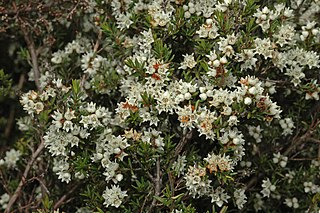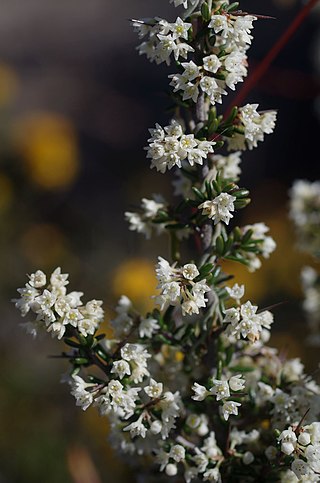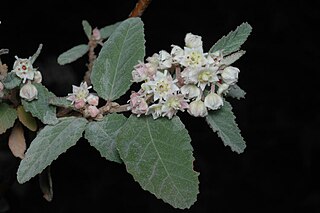
Grevillea biformis is a species of flowering plant in the family Proteaceae and is endemic to the south-west of Western Australia. It is a shrub with linear leaves and cylindrical clusters of creamy white or pale pink flowers.

Cryptandra tomentosa, commonly known as prickly cryptandra, is a species of flowering plant in the family Rhamnaceae and is endemic to the southern continental Australia. It is a small, straggling, erect to low-lying shrub sometimes with spiny branches, and has cylindrical leaves and loose clusters of white, bell-shaped flowers that turn pink to red as they age.
Cryptandra apetala is a species of flowering plant in the family Rhamnaceae and is endemic to the south-west of Western Australia. It is a shrub with tufted, linear to lance-shaped leaves, and urn-shaped white to creamy-white and pink flowers arranged on short side shoots.
Cryptandra exserta is a flowering plant in the family Rhamnaceae and is endemic to inland Western Australia. It is a shrub with narrowly oblong leaves and clusters of white, tube-shaped flowers.
Stenanthemum bremerense is a species of flowering plant in the family Rhamnaceae and is endemic to the southwest of Western Australia. It is an erect, or low spreading shrub with hairy young stems, broadly egg-shaped leaves and densely hairy heads of tube-shaped flowers, sometimes with whitish floral leaves.
Cryptandra graniticola is a flowering plant in the family Rhamnaceae and is endemic to southern Western Australia. It is an upright, spreading shrub with spiny branchlets, linear to narrowly egg-shaped leaves and clusters of white, tube-shaped flowers.
Stenanthemum coronatum is a species of flowering plant in the family Rhamnaceae and is endemic to the southwest of Western Australia. It is a prostrate shrub with sparsely hairy young stems, broadly egg-shaped leaves and densely shaggy-hairy heads of tube-shaped flowers.
Cryptandra inconspicua is a flowering plant in the family Rhamnaceae and is endemic to the southwest of Western Australia. It is a small, spreading shrub with narrowly elliptic to egg-shaped leaves and head-like clusters of white, tube-shaped flowers.
Cryptandra intratropica is a flowering plant in the family Rhamnaceae and is endemic to the Kimberley region of Western Australia. It is a slender, erect or spreading shrub with wedge-shaped to oblong or egg-shaped leaves and clusters of yellow to cream-coloured, tube-shaped flowers arranged in head-like clusters.
Stenanthemum limitatum is a species of flowering plant in the family Rhamnaceae and is endemic to the southwest of Western Australia. It is an erect or straggling shrub with sparsely hairy young stems, egg-shaped to fan-shaped leaves and greyish, softly-hairy heads of white or cream-coloured flowers.
Cryptandra micrantha is a flowering plant in the family Rhamnaceae and is endemic to the southwest of Western Australia. It is a prostrate or upright shrub with spiny branchlets, narrowly oblong to elliptic leaves and dense clusters of white or cream-coloured, tube-shaped flowers.
Cryptandra minutifolia is a flowering plant in the family Rhamnaceae and is endemic to the south-west of Western Australia. It is a spreading shrub with oblong to elliptic leaves and clusters of white or pink, tube-shaped flowers.

Thomasia paniculata, commonly known as few-flowered thomasia, is a species of flowering plant in the family Malvaceae and is endemic to the south-west of Western Australia. It is a slender, erect or straggling shrub with egg-shaped leaves and pink to purple, occasionally white flowers.
Stenanthemum petraeum is a species of flowering plant in the family Rhamnaceae and is native to inland Western Australia and the Northern Territory. It is a woody, erect shrub with densely hairy young stems, broadly egg-shaped to more or less round leaves, and clusters of white, densely shaggy- to woolly-hairy flowers.

Cryptandra pungens is a species of flowering plant in the family Rhamnaceae and is endemic to the southwest of Western Australia. It is an erect, slender, spiny shrub that typically grows to a height of 0.2–1 m with many short branches ending with thin spines. Its leaves mostly in bundles and are 4–6 mm (0.16–0.24 in) long. The flowers are white, each on a pedicel 1–2 mm (0.039–0.079 in) long with minute, overlapping brown bracts at the base. The sepals are about 1.6 mm (0.063 in) long and joined at the base to form a broadly bell-shaped tube, with lobes half as long as the tube. Flowering occurs from May to November. The species was first formally described in 1845 by Ernst Gottlieb von Steudel in Lehmann's Plantae Preissianae from specimens collected in sandy forest near Perth. The specific epithet (pungens) means "ending in a sharp, hard point".
Stenanthemum tridentatum is a species of flowering plant in the family Rhamnaceae and is endemic to the southwest of Western Australia. It is a prostrate to upright shrub with sparsely hairy young stems, egg-shaped to fan-shaped leaves, and creamy white or creamy-yellow flowers arranged singly or in groups of up to three.

Cryptandra recurva is a flowering plant in the family Rhamnaceae and is endemic to Western Australia. It is an erect, spreading shrub with densely hairy young stems, narrowly oblong to narrowly egg-shaped leaves and clusters of white, cream-coloured or off-white, tube-shaped flowers.

Commersonia erythrogyna, commonly known as Trigwell's rulingia, is a species of flowering plant in the family Malvaceae and is endemic to a restricted part of the south-west of Western Australia. It is an open, straggly shrub with oblong to egg-shaped leaves and creamy-white flowers.

Androcalva fragifolia is a species of flowering plant in the family Malvaceae and is endemic to the south-west of Western Australia. It is a straggling, prostrate shrub with glossy, broadly egg-shaped leaves, and creamy white flowers.
Androcalva microphylla is a species of flowering plant in the family Malvaceae and is endemic to the south-west of Western Australia. It is an open, straggling shrub with egg-shaped to oblong leaves with a heart-shaped base, and clusters of 5 to 7 white and dark red flowers.







